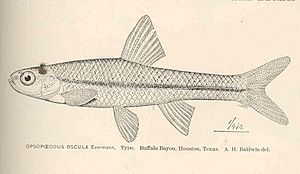Pugnose minnow facts for kids
Quick facts for kids Pugnose minnow |
|
|---|---|
 |
|
| Conservation status | |
| Scientific classification | |
| Genus: |
Opsopoeodus
|
| Species: |
emiliae
|
| Synonyms | |
|
|
The pugnose minnow (Opsopoeodus emiliae) is a small, interesting fish. It belongs to the minnow family. You can find this fish in the eastern parts of North America. There are two main types, or subspecies, of the pugnose minnow. One special type lives in Florida.
Contents
What Pugnose Minnows Look Like
The pugnose minnow is a small, silver fish. It usually grows to be about 1 to 2 inches long. Some can even reach 2.5 inches. This minnow has a forked tail and short fins near its chest. Its snout, or nose, is small and rounded.
A special feature of the pugnose minnow is its lateral line. This line runs all the way from its tail to its mouth. It helps the fish sense movements in the water. The minnow also has a mouth that points upwards. This means it mostly eats food floating above it in the water. Its top fin and tail fin are clear, like glass. The top fin has 9 bony supports.
Pugnose minnows usually live for about three years.
Diet and Eating Habits
Pugnose minnows mostly eat insects. Sometimes they might accidentally eat algae. If there aren't enough insects, they can eat other fish's eggs. They also munch on tiny water creatures. These include small crustaceans, like brine shrimp.
Special Features for Breeding
When male pugnose minnows are ready to mate, a black spot on their tail fin becomes very clear. Breeding males can also grow small bumps called tubercles on their snout. They use these bumps to fight other males. This helps them show who is strongest and attract a female.
Where Pugnose Minnows Live
The pugnose minnow is a freshwater fish. It lives in rivers and streams in Canada and the United States. You'll mostly find them along the eastern sides of these countries.
They can live in clear water. But they also like slow, cloudy water. These areas often have lots of plants or debris to hide under. In the United States, they adapt to many different water types. Some stay in the clear water where they hatched. Others might swim to places with more mud and clay.
Reproduction and Life Cycle
Pugnose minnows lay their eggs in late spring to early summer. They like to lay them under things in their habitat. This often means under rocks or logs.
First, the male minnow cleans a spot under a rock. He then defends this area from other males. He uses the bumps on his snout to fight them off. When a female comes by, the male gently nudges her. He uses his top fin to encourage her to lay eggs.
Female pugnose minnows lay sticky eggs. These eggs stick to the underside of the rock. They can be laid one by one or in strings. A female might lay about 120 eggs at one time. The male and female will repeat this process for about 6 or 7 days. After the eggs are laid, the female leaves. The male then guards the eggs until they hatch. This usually takes about 6 days, depending on the weather.
- Froese, Rainer, and Daniel Pauly, eds. (2011). "Opsopoeodus emiliae" in FishBase. August 2011 version.
- Government of Canada. Species at Risk Public Registry. N.p., n.d. Web. 23 Mar. 2017. <http://www.registrelep-sararegistry.gc.ca/species/speciesDetails_e.cfm?sid=107>.
- Wildlife, Ohio DNR Division of. "Ohio.gov / search." Ohio DNR Division of Wildlife. N.p., n.d. Web. 23 Mar. 2017. <http://wildlife.ohiodnr.gov/species-and-habitats/species-guide-index/fish/pugnose-minnow>


